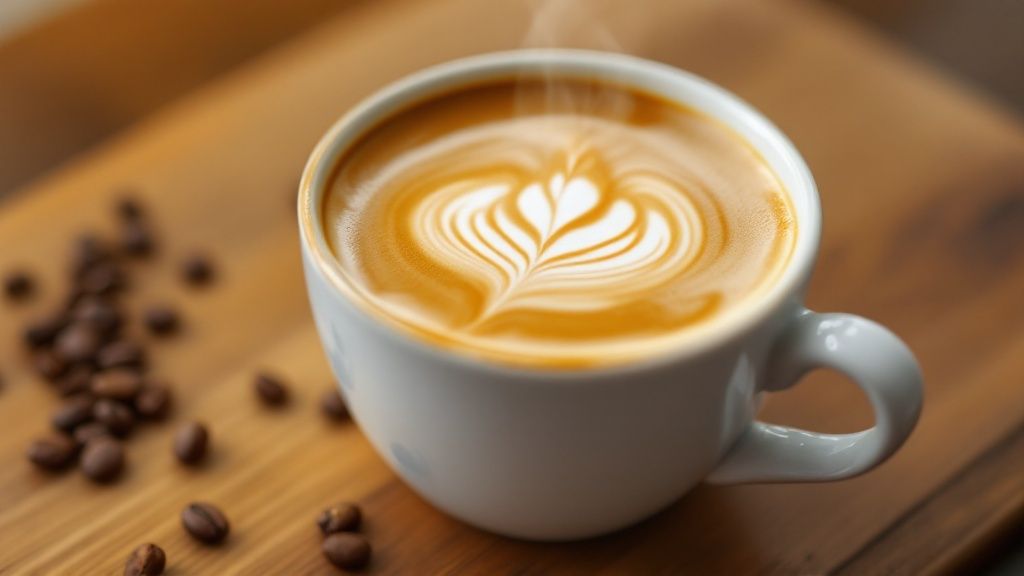
What Is Coffee Crema Unlocking Espresso's Golden Crown
Share
You know that gorgeous, reddish-brown foam that sits on top of a freshly pulled shot of espresso? That’s crema. It’s far more than just a pretty topping; this velvety layer is the hallmark of a quality shot, a clear sign that you’re using fresh coffee beans and your extraction was spot on.
It’s the first thing you see, smell, and taste—the promise of a rich and aromatic experience to come.
Your Espresso's Golden Crown Explained
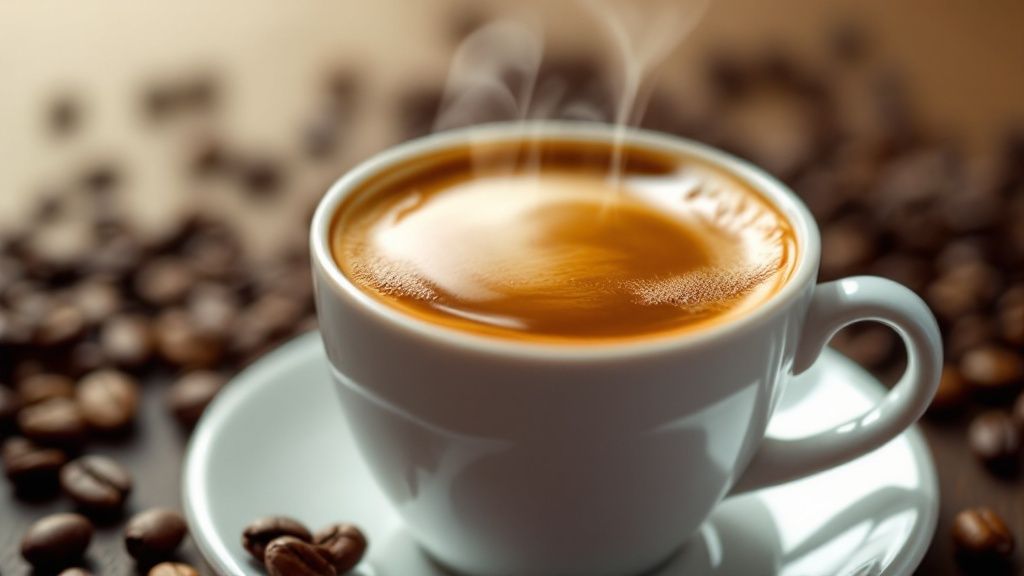
So, beyond its good looks, what exactly is this golden crown? Think of it as the very soul of the shot, a delicate emulsion born from the intense pressure of the espresso machine.
When hot water is forced through finely-ground coffee at high pressure, it does two things. First, it emulsifies the coffee's natural oils. At the same time, it dissolves the carbon dioxide gas that’s been trapped inside the beans since they were roasted. As the liquid espresso hits your cup, the pressure suddenly drops back to normal. This allows the CO2 to escape, expanding into thousands of tiny, stable bubbles that form the foam we call crema.
Crema is the ultimate sign of a masterfully pulled shot, promising a rich, complex, and deeply satisfying experience. It is the visual promise of the incredible flavour that awaits.
Here in the UK, where the coffee scene is more vibrant than ever, a flawless crema is often what separates an average coffee from a truly exceptional one. It tells you a story of freshness and skill before you’ve even taken a sip.
- Aroma: Crema traps the most volatile aromatic compounds, so when you lean in, you get an intense burst of fragrance.
- Flavour: It also contributes to the flavour profile, often adding a subtle, lingering sweetness that beautifully balances out any bitterness.
- Mouthfeel: The texture is everything. Crema provides that smooth, velvety quality that gives the espresso its body and richness.
This delicate foam is made possible by the emulsified oils and CO2 released during extraction, a process that happens under roughly 9 bars of pressure. If you want to dive deeper, you can discover more insights about the UK's love for quality coffee and what makes it tick.
The Science Behind a Perfect Crema
That beautiful, caramel-coloured foam doesn't just appear by magic. It’s the result of a stunning bit of chemistry and physics happening right inside your espresso machine—a high-pressure dance between hot water, finely ground coffee, and a crucial invisible ingredient: carbon dioxide (CO2).
During the roasting process, CO2 gas gets trapped deep within the coffee beans. When your espresso machine forces hot water through the compacted coffee grounds at around 9 bars of pressure, it does two things at once. First, it emulsifies the coffee’s natural oils. Second, it dissolves this trapped CO2 into the water.
As this super-pressurised, gas-infused liquid hits your cup, it returns to normal atmospheric pressure. This sudden drop causes the dissolved CO2 to rapidly expand, forming thousands of tiny, stable bubbles. These bubbles, wrapped in the emulsified oils, create the rich, persistent foam we all know and love as crema.
The Key Players in Crema Creation
If you want that luscious, picture-perfect crema, the freshness of your coffee beans is completely non-negotiable.
As roasted beans age, they slowly release their trapped CO2 in a process called degassing. If the beans are too old, they simply won't have enough of this vital gas left to produce a thick, stable crema. It’s why freshly roasted coffee is the hero of every great espresso shot; the abundant CO2 guarantees a robust reaction when it meets the hot, pressurised water.
This infographic breaks down the essential steps of this fascinating process.
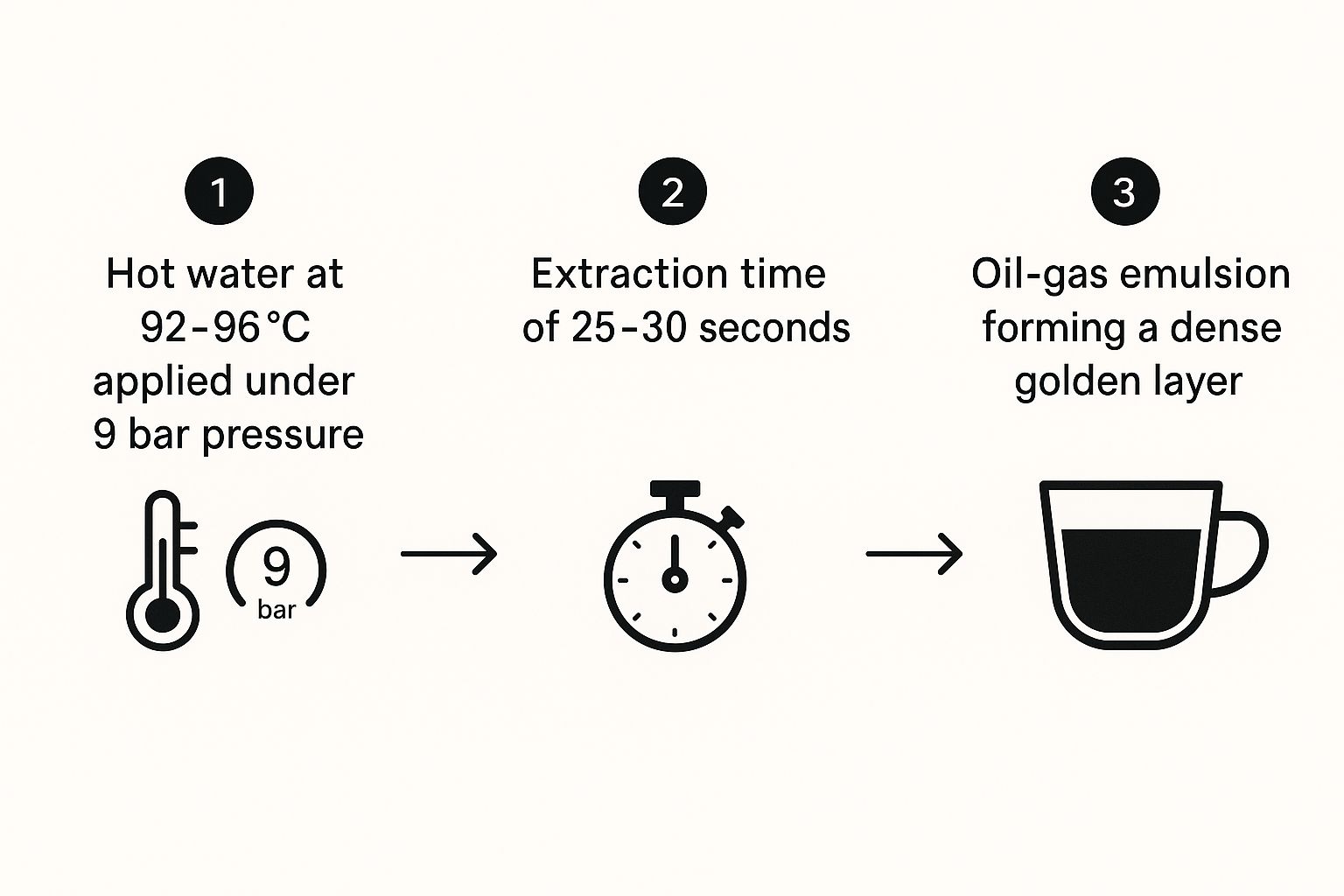
As you can see, creating crema isn't a single event. It’s a sequence where temperature, pressure, and time have to work together perfectly.
At its core, crema is the visual proof of a well-executed extraction. It’s the direct result of forcing water to extract soluble solids, oils, and gases from fresh coffee under immense pressure.
Ultimately, this whole scientific process is what gives crema its defining characteristics:
- Aromatic Oils: These carry much of the coffee's complex flavour and aroma.
- Carbon Dioxide: This provides the structure and lightness of the foam.
- Emulsified Solids: These contribute to the rich colour and velvety mouthfeel.
Understanding the science behind it all turns your coffee-making from a simple routine into a proper art form. It gives you the knowledge to chase that perfect, golden crown with every single shot you pull.
What Your Crema Is Telling You
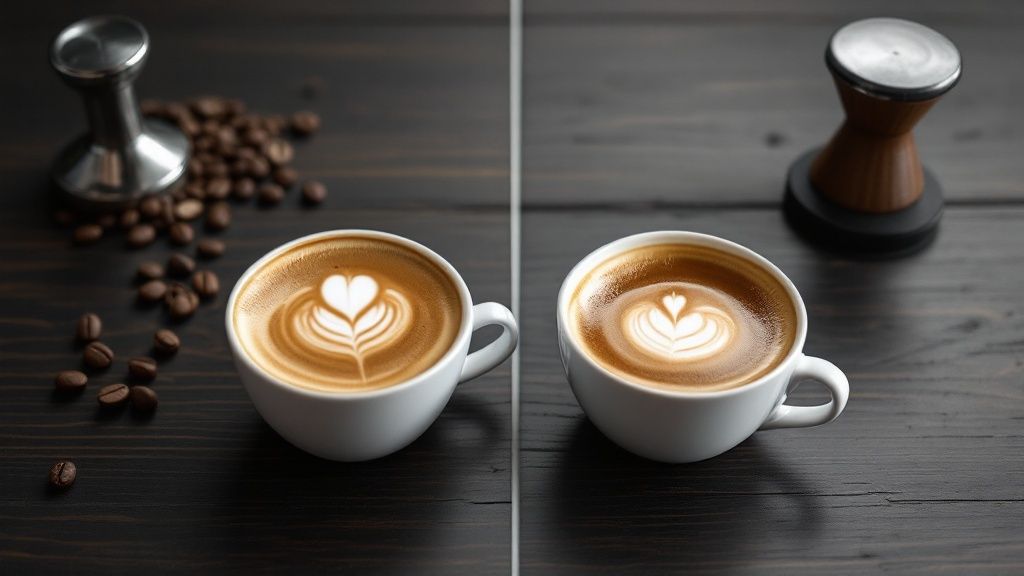
Think of your crema as a visual report card for your espresso shot. It’s a beautiful, honest storyteller, revealing secrets about your beans, your grind, and the pull itself. Learning to read its language is one of the most empowering skills any home barista can develop.
Instead of just seeing foam, you’ll start to see a roadmap to a better brew. Each shot you pull offers instant feedback, giving you a chance to tweak your technique and get one step closer to that perfect, café-quality cup you’re chasing.
This isn't about aiming for some impossible standard; it's about connecting with your coffee on a deeper level. By understanding these visual clues, you go from someone who just makes coffee to someone who truly understands it.
Reading the Signs in Your Cup
Your crema’s colour, thickness, and how long it lasts all tell a different part of the story. A quick glance can tell you whether your shot was a success or if there’s room for improvement. The key is knowing what to look for.
-
Thin and Pale Crema: This often points to under-extraction. The water probably rushed through the coffee too quickly, which could mean your grind is too coarse or you haven't dosed enough coffee. It can also be a tell-tale sign of stale beans that have lost their precious CO2.
-
Dark and Patchy Crema: If you see a very dark brown crema with splotches or a big hole in the middle, it likely signals over-extraction. This happens when the water takes too long to pass through, often because the grind is too fine or you've tamped with too much force.
-
Bubbly and Fast-Fading Crema: A crema with large, soapy-looking bubbles that vanishes in a flash can mean your beans are too fresh. They haven't had enough time to degas after roasting. Just give them a few more days to rest.
The ideal crema is your ultimate goal: a consistent, lasting layer of hazelnut-brown foam with fine bubbles. Beautiful "tiger striping"—the mottled patterns that appear as the shot pours—is another hallmark of a superb extraction.
This perfect crema should hang around for at least two minutes, a testament to a well-balanced shot.
To make things even clearer, here’s a quick guide to help you decode what’s happening in your cup.
Decoding Your Coffee Crema
| Crema Appearance | Potential Cause | How to Fix It |
|---|---|---|
| Thin, pale & disappears quickly | Under-extraction (grind too coarse, stale beans) | Use a finer grind setting. Ensure your coffee beans are fresh. |
| Dark brown, patchy, with a hole | Over-extraction (grind too fine, too much tamping pressure) | Use a coarser grind setting. Ease up on your tamping pressure. |
| Very thick with large bubbles | Beans are too fresh (not degassed enough) | Let your beans rest for a few more days after the roast date. |
| Hazelnut-brown, persistent & fine | A well-balanced extraction (ideal shot!) | Nothing! Enjoy your perfectly pulled espresso. |
By paying attention to these details, you can troubleshoot your process and really dial in your settings. This intuitive approach empowers you to consistently pull shots you can be proud of, turning every coffee into a little masterpiece.
How to Achieve Rich Crema at Home
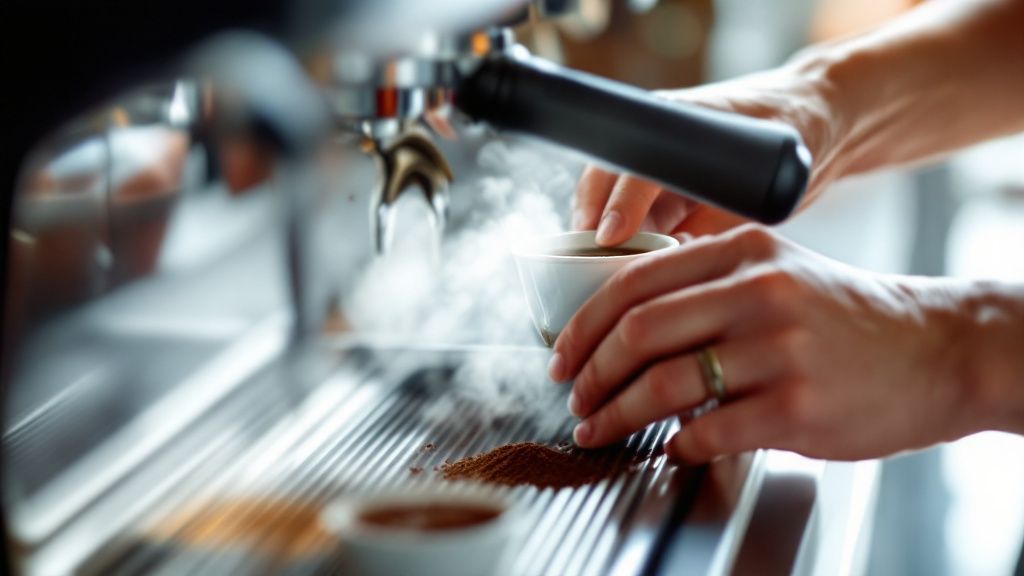
Creating that beautiful, rich crema is an art form, but it’s one you can absolutely master at home. It isn't about some secret barista handshake; it's about paying attention to a few core principles. This is your guide to turning theory into a delicious result, cup after cup.
Getting that perfect crema really boils down to four key pillars. Nail these, and you'll build a consistent foundation for pulling incredible espresso shots every single time. It's how you get that café-quality experience in your own kitchen.
The Four Pillars of Perfect Crema
Achieving a flawless crema is all about balancing a few crucial variables. When you get them working in harmony, the results feel like magic. It all starts with the beans and ends with the final pour.
Here’s what you need to focus on:
- Incredibly Fresh Beans: This is completely non-negotiable. Crema is born from the carbon dioxide trapped inside beans during roasting. Coffee roasted within the last few weeks will have the most CO2, which is what gives you that thick, luscious foam.
- The Right Grind Size: You're looking for the 'sweet spot'. The grind needs to be much finer than what you’d use for a drip coffee, but not a fine powder like flour. This creates the ideal resistance for the water to extract all those wonderful flavours evenly.
- Consistent Tamping Pressure: Tamping isn't about brute force. The real goal is a level and consistent press that creates a compact puck of coffee. This encourages water to flow through evenly, preventing 'channelling' and ensuring a balanced extraction.
- Optimal Machine Settings: Make sure your espresso machine is properly heated and delivering water at the right temperature (typically 90-96°C) and pressure (around 9 bars). Consistency is absolutely key here for repeatable results.
"The quest for perfect crema is a journey of precision and passion. It's about respecting the coffee and understanding the beautiful science that transforms it."
These skills are constantly being refined across the UK's vibrant coffee industry, which employs around 210,000 people. As more and more people move away from instant coffee, a good crema has become a real benchmark of quality, driving demand for exceptional, barista-made drinks. You can discover more about the trends shaping the UK's coffee market and its impressive growth.
By focusing on these four pillars, you stop leaving your espresso to chance and start intentionally crafting it. You’ll be amazed at how quickly your home coffee game improves with just a little attention to detail, giving you a perfect answer to what is coffee crema and how to achieve it.
Why Crema Is a Barista's Benchmark
Walk into any great coffee shop, and you'll notice the one thing that separates a good espresso from a truly great one: the crema. That beautiful, reddish-brown layer isn't just froth; it’s a silent conversation between the barista and the person waiting for their coffee. It’s a visual handshake, a sign that everything—from the freshness of the beans to the machine's calibration—is working in perfect harmony.
For professionals behind the counter, a rich, stable crema is the ultimate measure of a well-pulled shot. It's the first proof that the drink was made with fresh coffee and genuine care. More than that, it shows the barista has mastered the delicate dance of pressure and time needed to get it just right.
A flawless crema is more than just a pretty topping. It's the canvas for latte art and the secret to the velvety mouthfeel in drinks like flat whites and cappuccinos. It's the first impression, setting the tone for the entire experience.
The Signature of Quality
This obsession with crema isn't just for show. A thick, lasting crema is a sign of a masterful extraction, where all the coffee’s precious aromatic oils and soluble solids have been perfectly emulsified. It tells you the barista has unlocked every bit of flavour hidden inside the beans.
- Consistency: A true pro can pull a shot with a perfect crema every single time, proving their technique is locked in.
- Customer Experience: For the customer, it’s a simple assurance: you’re about to enjoy a premium coffee made with real passion.
- Flavour & Texture: It’s not just looks. The crema directly contributes to a balanced taste and gives the coffee that luxurious texture we all love.
By understanding why baristas are so focused on it, you can start to see your own home brewing in a new light. The pursuit of the perfect crema is a rewarding journey that connects you to the wider world of speciality coffee.
Frequently Asked Questions About Crema
Even after you get to grips with the science of crema, a few questions always seem to pop up on the journey to the perfect espresso. Let's clear up some of the most common curiosities and give you the knowledge to brew with complete confidence.
Think of these answers not as strict rules, but as signposts to guide you. Every question gets you one step closer to mastering the art of espresso and truly understanding what that golden layer brings to your cup.
Does The Type Of Coffee Bean Affect Crema?
Absolutely. The coffee bean you choose plays a starring role in the final result. Robusta beans, for instance, are famous for producing a much thicker, more stable crema, which is largely down to their higher oil content.
That said, many coffee lovers find that Arabica beans produce a finer, more aromatic crema that offers a greater depth of flavour. A medium to dark roast is often the sweet spot, as the roasting process helps bring those essential oils to the surface and develops the CO2 needed for crema to form. But ultimately, freshness is the most crucial factor, no matter what bean you're using.
The perfect crema is a symphony of variables, with your bean choice acting as the lead instrument. Your preference for a bold or delicate flavour will guide you to the right one.
Can I Get Crema With Other Brewing Methods?
No, true crema is unique to the espresso brewing method. Its formation depends entirely on emulsifying coffee oils under intense pressure—typically 9 bars or more.
Brewing methods like a French press, pour-over, or drip coffee machine simply can't generate that kind of force. While some might produce a light foam on the surface, it lacks the density, stability, and complex flavour of an authentic espresso crema. It’s the pressure that unlocks that golden crown.
Is More Crema Always Better?
Not necessarily. While a healthy, persistent layer of crema is a fantastic sign of a well-pulled shot, quality always trumps quantity. An excessive amount of very light, bubbly foam can sometimes be a sign that the beans are too fresh and haven't had enough time to rest after roasting.
Your goal should be a fine, richly coloured, and persistent crema, not a huge volume of airy foam. Strive for balance; this is where you'll find the most satisfying and flavourful espresso.
Is Crema From A Pressurised Portafilter Real?
Pressurised, or 'dual-wall', portafilters are designed to create a foam that looks like crema, even when you're using pre-ground coffee or a less-than-perfect grind. They achieve this by forcing the coffee through a single tiny hole, which aerates the liquid.
While it might look similar, this 'faux crema' is generally lighter, has larger bubbles, and disappears much faster. True crema is born from the perfect interaction of high pressure with the oils and gases in freshly ground coffee—it's a testament to both skill and quality ingredients.
At Ue Coffee Roasters, we understand that exceptional coffee transforms the workplace. We provide premium, speciality coffee solutions, including commercial bean-to-cup machines, to bring the quality of a high street café directly to your office. Elevate your team's coffee experience today.
